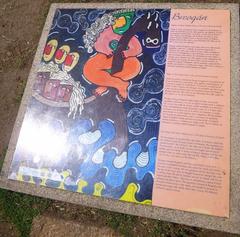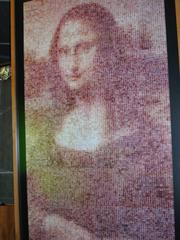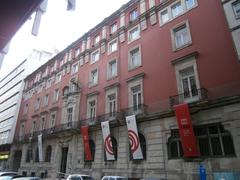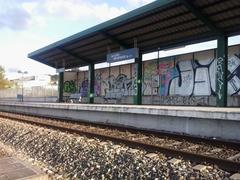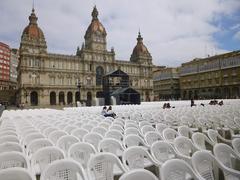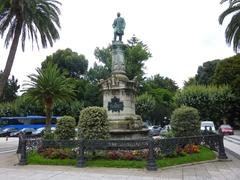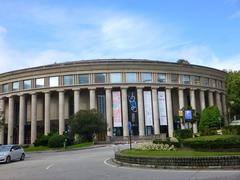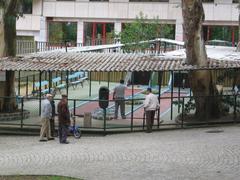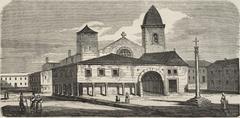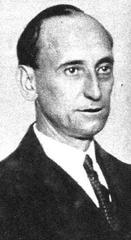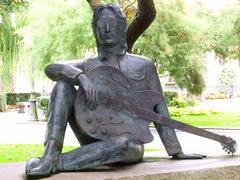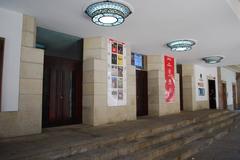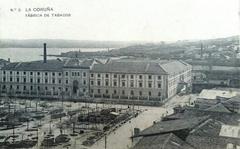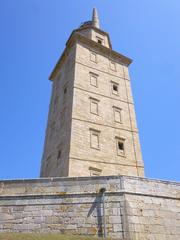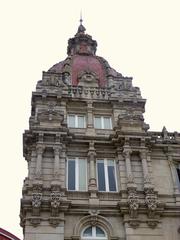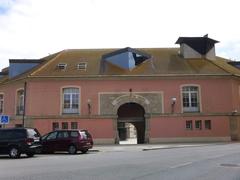
Convent of San Domingos A Coruña: Visiting Hours, Tickets, and Historical Site Guide
Date: 04/07/2025
Introduction
Nestled in the historic heart of A Coruña, Spain, the Convent of San Domingos is a monument that bridges medieval origins and Baroque grandeur. Founded by the Dominican Order in the 13th century, this convent has played witness to centuries of spiritual devotion, artistic achievement, and community life. Its architectural evolution—from the Gothic beginnings, through destruction during Sir Francis Drake’s 1589 attack, to its Baroque-era reconstruction—makes it an essential site for understanding Galicia’s religious and cultural heritage. Today, it remains a vibrant center for Marian devotion, local religious festivities, and community engagement.
This comprehensive guide offers:
- An in-depth history of the convent and its architecture
- Practical information on visiting hours, tickets, accessibility, and guided tours
- Tips for exploring nearby attractions such as the Tower of Hercules and the Old Town squares
- Answers to frequently asked questions and travel advice
For additional details, consult the official Ayuntamiento de A Coruña and Patrimonio Galego.
Table of Contents
- Introduction
- Historical Overview
- Architectural Evolution
- Cultural and Religious Significance
- Visiting Information
- Architectural Curiosities
- Surviving Medieval Elements
- FAQs
- Plan Your Visit
- Visual Gallery
- Map
- References
Historical Overview
Origins and Foundation
The Convent of San Domingos was established by the Dominican Order in the 13th century, originally outside the medieval city walls at the site of the present Cuartel de Atocha. This strategic location reflected the Dominicans’ growing influence in Galicia, serving as a center for worship, learning, and the burial of local nobility (Patrimonio Galego). By the 14th and 15th centuries, the church had become a prestigious pantheon for A Coruña’s aristocracy and mirrored the layout of the Convent of San Francisco.
Destruction and Relocation
In 1589, the convent was left in ruins after the English assault led by Sir Francis Drake. The Dominicans soon decided to relocate within the protective walls of the Ciudad Vieja, and by 1613 the new church was open for worship. Salvaged elements from the previous Gothic church, such as the tympanum and vault keys, are still visible on the exterior apse wall (Ayuntamiento de A Coruña).
Architectural Evolution
Gothic and Romanesque Features
The original convent featured Gothic architecture typical of mendicant churches. The surviving tympanum, now set into the exterior wall, depicts a Romanesque-Gothic Virgin and Child—one of the few medieval sculptures of its kind in Galicia.
Baroque Transformation
Between 1763 and 1787, the convent underwent a significant Baroque transformation. The Latin cross plan of the church features a straight apse, short transept, and a choir-tribune above the nave’s entrance. The interior is adorned with Tuscan pilasters, reinforced arches, groin vaults in the presbytery, and a barrel vault with lunettes in the nave. The dome at the crossing is supported by pendentives, adding vertical drama to the space (Patrimonio Galego).
Facade and Tower
The late Baroque facade is monumental, with Doric pilasters and a festooned entablature. The lintelled doorway sits beneath a blind arch, while a curved niche window lights the interior. Uniquely, the facade’s alignment is oblique due to the footprint of the earlier structure, giving the bell tower the illusion of being askew when it is actually aligned with the church’s axis.
The bell tower features a sturdy quadrangular base, topped by an octagonal belfry and cupola, accented by cornices and balustrades (Patrimonio Galego).
Chapels and Interior Features
Two chapels of note are the Chapel of Our Lady of the Remedies (1663) and the Chapel of the Rosary, the latter dedicated to the city’s patroness. Both chapels survived the 18th-century reconstruction and remain important sites of devotion (Patrimonio Galego).
Cultural and Religious Significance
The convent has been a spiritual cornerstone in A Coruña. Its chapels host annual religious festivities and processions, particularly in honor of the Virgin of the Rosary. Historically, it was also a burial place for local nobility, reflecting both religious and social prestige (Patrimonio Galego).
Visiting Information
Opening Hours
- Monday to Saturday: 10:00 AM – 1:30 PM and 4:00 PM – 7:30 PM
- Closed Sundays and public holidays
Verify up-to-date hours on the official website.
Tickets and Admission
- General admission is free.
- Special guided tours or events may require tickets, which can be purchased online or at the local tourist office.
Accessibility
- The convent is wheelchair accessible, with ramps and adapted facilities.
- Contact the site in advance for additional assistance, if required.
Guided Tours and Visitor Tips
- Guided tours are available by request and offer in-depth historical and architectural insights.
- Weekday mornings are best for a quieter experience.
- Photography is allowed, but flash and tripods may be restricted; check signage.
Nearby Attractions
Enhance your visit by exploring the historic Ciudad Vieja, the nearby Convent of San Francisco, the Tower of Hercules, and the Museum of Fine Arts.
Architectural Curiosities
A notable feature is the alignment of the bell tower: though it appears misaligned from some perspectives, it is perfectly aligned with the church’s axis. The oblique facade results from the adaptation to the footprint of the earlier Gothic church (Ayuntamiento de A Coruña).
Surviving Medieval Elements
Key medieval elements that have survived include the Romanesque-Gothic tympanum of the Virgin and Child and several 13th-century vault keys, providing a direct link to the convent’s origins (Patrimonio Galego).
Frequently Asked Questions (FAQ)
Q: What are the visiting hours?
A: Monday to Saturday, 10:00–13:30 and 16:00–19:30. Closed Sundays and holidays.
Q: Is there an entrance fee?
A: Admission is free. Special tours or events may have a fee.
Q: Are guided tours available?
A: Yes, by appointment via the tourist office or convent administration.
Q: Is the convent wheelchair accessible?
A: Yes, ramps and adapted facilities are available.
Q: Where can I get tickets for special events?
A: Online or at the A Coruña tourist office.
Plan Your Visit
Find the latest updates on hours and events at the Ayuntamiento de A Coruña official page and Patrimonio Galego.
Download the Audiala app for guided tours, maps, and up-to-date visitor information.
Visual Gallery
Images to include: “Facade of Convent of San Domingos in A Coruña,” “Baroque interior of Convent of San Domingos,” and “Medieval tympanum at Convent of San Domingos.”
Map
Interactive map pinpointing the Convent of San Domingos and nearby attractions.
Location and Access
- Address: Praza de Santo Domingo 1, 15001 A Coruña, Spain
- Phone: +34 981 218 054
- Website: Concello da Coruña
Centrally located in the Cidade Vella, the convent is easily reached by foot or public transit. The lively Praza de Santo Domingo hosts local events, adding to the experience (Explorial).
Visitor Facilities and Accessibility
- Entrance: Street level; mostly accessible.
- Parking: Limited nearby; walking is recommended due to narrow streets.
- Restrooms: Limited on site; nearby cafés have facilities.
- Language: Spanish and Galician are spoken; some tourism staff speak English.
Guided and Self-Guided Tours
- Guided tours may be arranged through local providers; many walking tours of the old town include the convent.
- Information plaques in Spanish and Galician; some audio guides available.
Dress Code and Etiquette
- Modest attire is required (cover shoulders and knees).
- Silence and respect are expected during Mass.
- Photography may be restricted during services; follow posted guidelines.
Safety and Travel Tips
- A Coruña is safe and tourist-friendly; dial 112 for emergencies (Audiala).
- Spring and summer are ideal for visiting, with mild temperatures and lively festivals.
- Pickpocketing is rare, but remain aware in crowded areas.
Summary
The Convent of San Domingos is a living testament to A Coruña’s medieval and Baroque heritage, offering free admission, accessible facilities, and a rich tapestry of art and devotion. Its central location makes it a perfect starting point for exploring the city’s historical treasures.
Plan your visit with the help of the Audiala app, and consult official resources for the latest updates. Discover centuries of history and immerse yourself in Galicia’s enduring faith and culture.
References
- Patrimonio Galego
- Ayuntamiento de A Coruña
- Dominicos Hispania
- Concello da Coruña
- Explorial
- Galicia Guide
- Audiala






